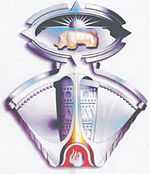Order of Mapungubwe
| Order of Mapungubwe | |
|---|---|
 | |
| Awarded by President of South Africa | |
| Type | National Order |
| Status | Currently constituted |
| Grades (w/ post-nominals) |
|
| | |
| Ribbon | |
The Order of Mapungubwe is South Africa's highest honour.[1] It was instituted on 6 December 2002, and is granted by the president of South Africa, for achievements in the international area which have served South Africa's interests. The order originally had three classes, and was enlarged to four in 2004:
- Platinum (OMP), for exceptional and unique achievements,
- Gold (OMG), for exceptional achievements,
- Silver (OMS), for excellent achievements,
- Bronze (OMB), for outstanding achievements.
The order is named after Mapungubwe,[2] an ancient African nation which existed a thousand years ago in what is now the northern part of the Limpopo province.
The first recipient of the order (in the Platinum class) was ex-president Nelson Mandela.
Design
The badge is a horizontal oval above an inverted trapezium. Inside the oval frame is depicted a golden rhinoceros with the sun rising above Mapungubwe hill in the background. The convex upper edge of the trapezium is decorated with a beadwork pattern and the sides are edged with sceptres. In the centre is an ornate crucible from which molten gold flows down to a red furnace. The South African coat of arms is displayed on the reverse.
The ribbon is gold, edged with a line of cream-coloured bead-like dots along each edge, and recurring cream-coloured rhinoceros silhouettes down the centre. All four classes are worn around the neck.
Recipients
2002
- Madiba - Platinum (national reconciliation and nation-building)
- Allan Cormack - Gold (scientist credited for co-inventing the cat-scan)
- FW de Klerk - Gold (national reconciliation and nation-building)
- Basil Schonland - Gold (physicist and founding president of the Council for Scientific and Industrial Research)
- Peter Beighton - Bronze (research into the inherited disorders of the skeleton)
- Hamilton Naki - Bronze (medical science)
2004
- Sydney Brenner - Gold (medical science)
- Tshilidzi Marwala - Bronze (engineering science)
- Batmanathan Dayanand Reddy - Bronze (mathematics and science)
2005
- John Maxwell Coetzee - Gold (literature)
- Aaron Klug - Gold (medical science)
- Tyeid Nunes Nabarro - Gold
- Tebello Nyokong - Bronze (research into the development of cancer treatments)
- Himladevi Soodyall - Bronze
2006
- Selig Percy Amoils - Silver (pioneering medical achievements)
- George Ellis - Silver (mathematics and science)
- Lionel Opie - Silver (knowledge and achievements in the field of cardiology)
- Professor Patricia Berjak- Silver ( Seed biologist)
2007
- Claire Penn - Silver (speech and language pathology, sign language, aphasia)
- Sibusiso Sibisi - Silver (information technology, R&D)
- Valerie Mizrahi - Silver (biochemistry and molecular biology, including TB drug validation)
2008
- Doris Lessing - Gold (literature, contributing to the elimination of colonialism and apartheid)
- Douglas Butterworth - Silver (betterment of the environment and sustainability of fisheries)
- Wieland Gevers - Silver (higher education and medicine)
- Phuti Ngoepe - Silver (natural sciences, development of computer Modelling studies at the University of Limpopo)
- Tim Noakes - Silver
- Pragasen Pillay - Silver (energy conservation)
2010
- Johann Lutjeharms - Silver (oceanographic science, contribution to and achievements in)
2012
- Oliver Tambo Junior - Platinum (for his grandfather Oliver Reginald Tambo's anti-apartheid legacy[3]) from President Jacob Zuma during the national orders award ceremony in Pretoria, South Africa on April 27, 2012.
See also
- South African civil honours
External links
References
- ↑ "The Order of Mapungubwe". The Presidency (Republic of South Africa). Archived from the original on 2007-04-20. Retrieved 2007-04-29.
- ↑ http://www.thepresidency.gov.za/pebble.asp?relid=776
- ↑ Tambo, Oliver. "Oliver Tambo".
| |||||||||||||
